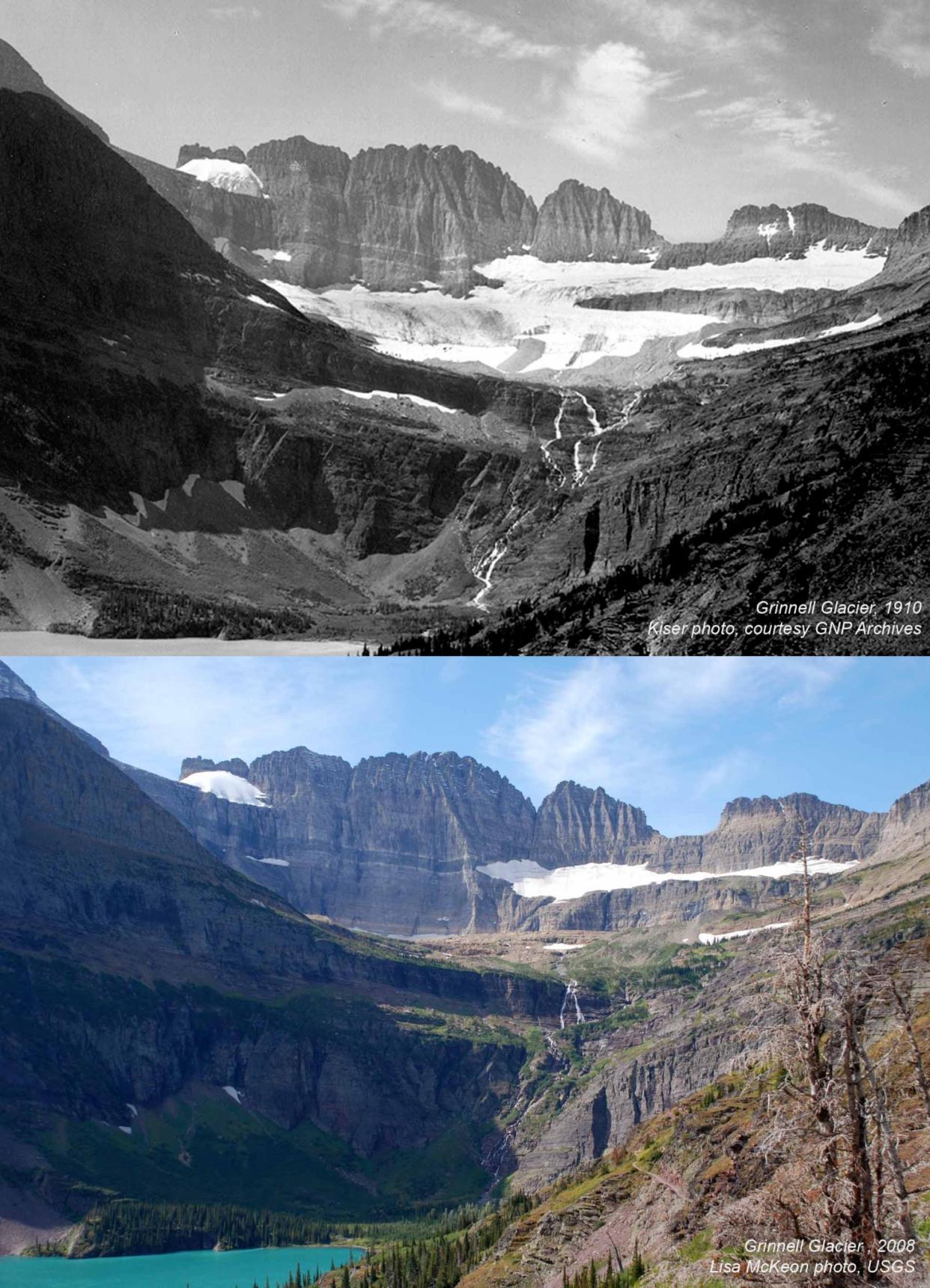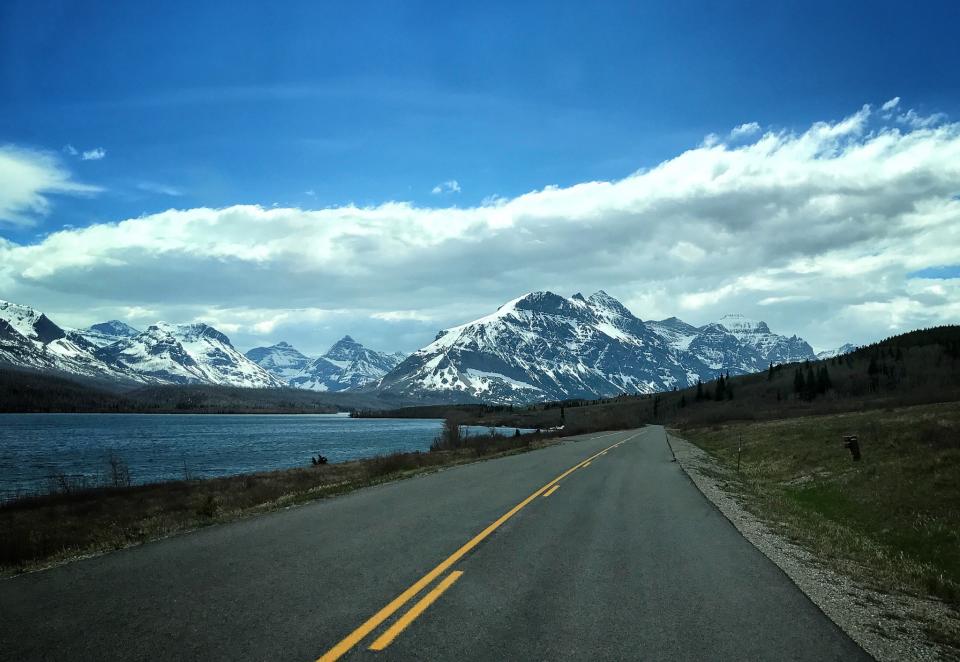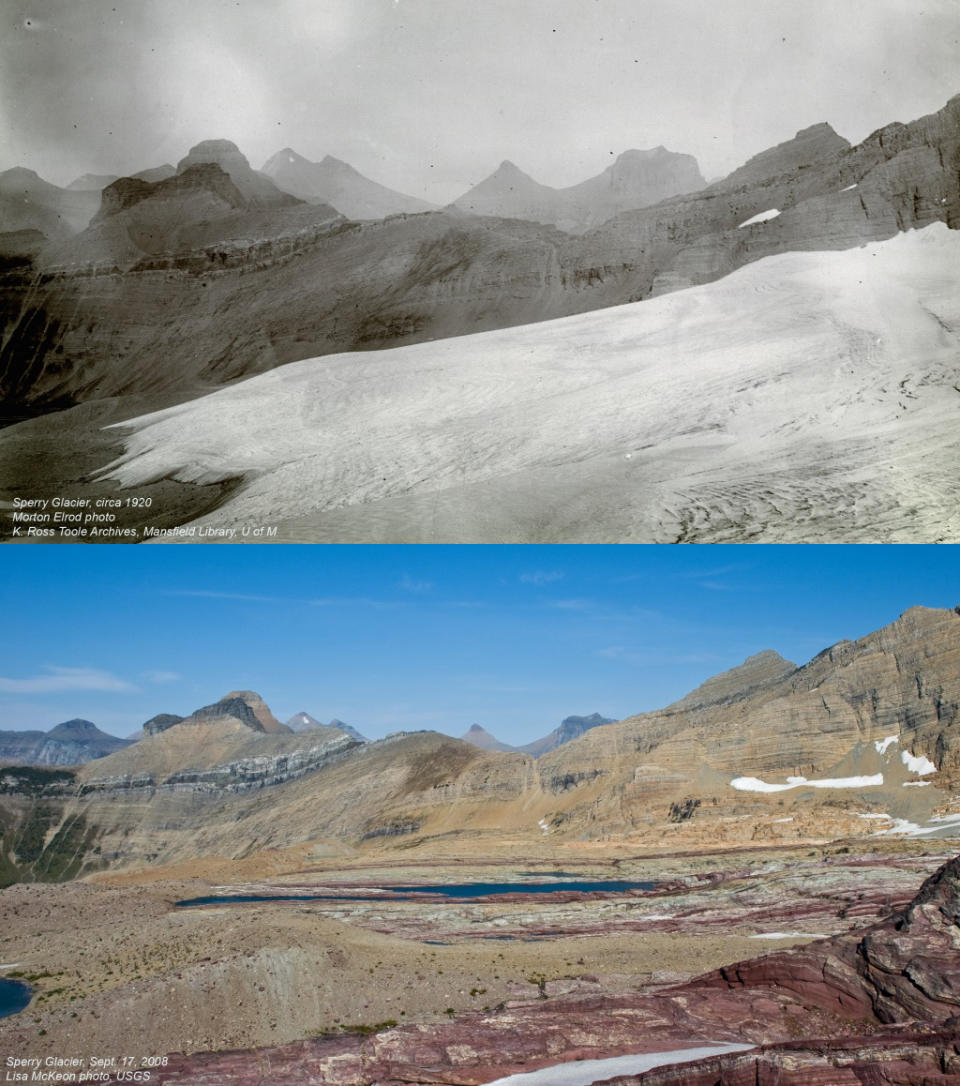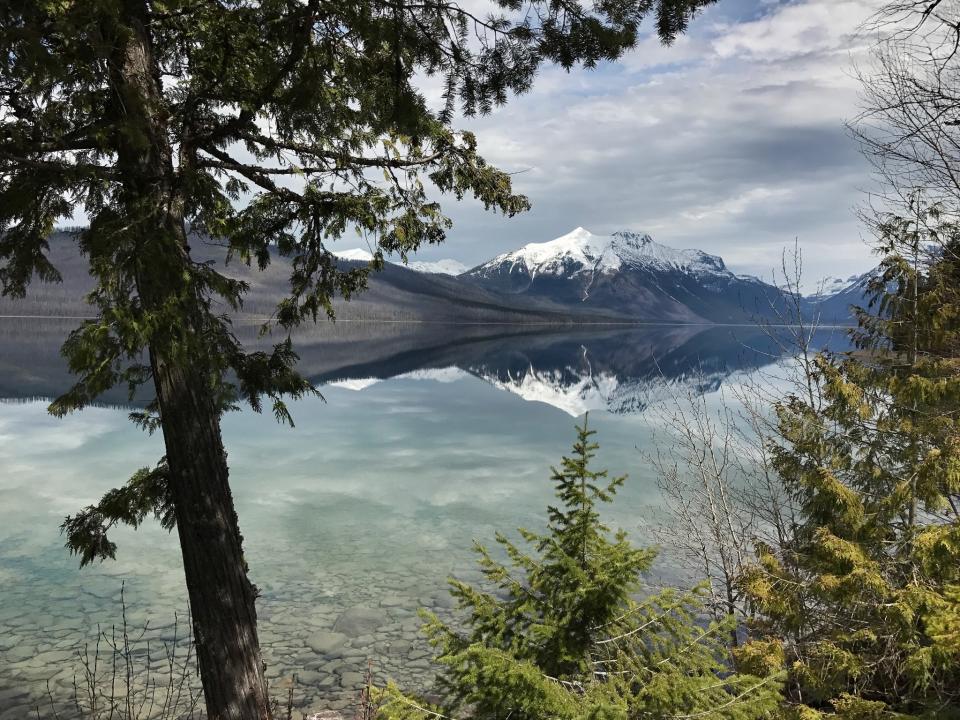Measuring the glaciers of Glacier National Park, and watching them disappear

GLACIER NATIONAL PARK, Mont. — They call this national park the “crown of the continent,” and Grinnell Glacier is one of its jewels.
Named after an explorer who championed the creation of the park, Grinnell was once a long sheet of milky white ice that sprawled through a valleylike crevice along the Continental Divide, lasting evidence of the ice age that long ago created the picturesque jagged peaks and cliffs that make this landscape in far northern Montana so unique.
It was one of the first glaciers that Dan Fagre visited when he came to work here in 1991, back when most Americans had never heard of the phrase “climate change.” A research ecologist with the U.S. Geological Survey, he was hired to come to Glacier to assess what members of Congress who had funded his research then called “global change.”
More than 20 years later, Fagre still marvels at that first hike up to Grinnell, a steep path that winds for miles up a rocky incline through waterfalls and lakes so clear and vibrant blue that many who visit liken the pristine landscape to a dream. At the top, he and his team found themselves walking through an ice cave below a formation that rose hundreds of feet above their heads. It was part of the glacier, which spread out for 220 acres around them.
As a scientist, Fagre tries to play it cool, but even now, the 64-year-old smiles like a kid at the memory. “It was incredible,” he said.
But that visit was bittersweet. At the time, Grinnell, like many of the glaciers that make up the storied park, was in what scientists call “retreat.” In 1991 it was already less than a third of the 750 acres it covered when it was first measured in 1850. Today, the USGS projects its size at less than 150 acres, if that, and shrinking faster than ever because of climate change.

Grinnell’s towering formation is long gone. The ice, which used to be hundreds of feet thick, is now no taller than knee height at some points, and parts of it are visibly dripping. Within the last few years, the runoff from the melting glacier has been enough to spawn a new body of water just below it. Upper Grinnell Lake, as it is called, is often full of icebergs, chunks that have broken off from the glacier above — all part of a great melt that will soon strip Glacier National Park of its identity.
When President William Howard Taft created Glacier National Park back in 1910, there were 150 glaciers in the park — enough that visitors could easily see many from the road and walking trails well below the mountains. By 1993, there were just 50 glaciers, many in hard-to-access remote areas of the park, and now there are only 26 — with some so shrunken that scientists debate whether to classify them as glaciers at all.
According to a joint study released Wednesday by the USGS and Portland State University, the glaciers at Glacier National Park have declined in size by 39 percent on average since 1966 — with some having shrunk by as much as 85 percent, according to data gleaned from aerial photography, satellites and ground measurements.
Before he came to Montana, Fagre specialized in animal ecology, tracking the impact of changes in climate on wildlife. While he still does that, his job is now consumed by watching and measuring the glaciers as they melt away, icons of nature that until a few years ago he never imagined losing in his lifetime. Now Fagre projects that the glaciers will likely be gone by 2030, if not sooner. And scientists say that rapid melting has earned Glacier the sad distinction of being one of the most visible signs of climate change in the U.S.
“Things that usually happen in geologic time are happening in human time, faster than anyone ever imagined,” he said. “We are now on the brink of having a glacierless Glacier National Park.”
To many here in Montana, especially those who live in the surrounding valleys that have a clear view of the soaring mountains in and around Glacier National Park, the loss of the park’s iconic glaciers is akin to losing Mount Rushmore or the Statue of Liberty — something that strikes at the heart of their identity.

Yet Glacier’s changing landscape offers a glimpse into the debate over climate change, which is complicated even here in Montana, where residents have what scientists say is a front row view of the impact of the earth’s warming temperatures. Virtually everyone here agrees that the climate is changing — that climate change is not a hoax, as President Trump once claimed.
But the question of what is to blame for warming temperatures has prompted a highly emotional discussion that has played out in church pews, newspaper editorial pages, classrooms and even on the trails of the park, which has seen record crowds in recent years of tourists determined to see the glaciers before they vanish. “Doomsday tourism,” the locals call it.
Though the park is still operating under winter hours, with the famed Going-to-the-Sun route that cuts through the park closed because of snow accumulation, roads near the park’s west entrance were packed with cars last week. Near the shore of Lake McDonald, the park’s largest lake and one that is so clear it reflects the surrounding mountains like glass, scores of tourists stood with cameras and smartphones documenting the majestic view. It was nearly 80 degrees — an unusually warm day for northern Montana in early May.
One visitor, a woman named Linda from nearby Kalispell, about 45 miles southwest of the park, mentioned the temperature and questioned how anyone could doubt that “something was happening with the environment.” “It shouldn’t be so warm,” she said.
But Linda, who declined to give her last name, hesitated to say what she thought was causing the change. Scientists are virtually unanimous in the belief that human activities have caused most or all of the effects Fagre is seeing, and while Linda said she tended to agree, she didn’t want to cause friction with her friends or family who might see her comment in print. “I know a lot of people who think this is just the way the earth works, that man has nothing to do with it,” she said.
Down in the valley, the question has been divisive for the many churches in the shadow of the park. In at least one, parishioners have been known to pray for colder winters in hopes of preserving the few glaciers that are left. Still, several pastors declined to comment on the topic, refusing to wade into a subject that one said was “too politically fraught” for his congregation. “It’s in God’s hands,” he said.

At the same time, the debate has divided Montana voters into those who want the government to control greenhouse-gas emissions, and those who are motivated by the desire to protect the state’s energy industry, including coal mining — a hard-hit sector that is hoping for a revival under Trump.
Fagre operates out of a tiny century-old house near the park’s headquarters that used to shelter park rangers but is now an office for him and his three-person staff. One of the few climate change ecologists with the USGS who is based at a national park, Fagre is well aware of the intense debate over climate change, but so far he has stayed above the fray — and happily so. It helps, he says, that he works for a government agency that deals “only in facts” and “presenting those facts without advocacy.” And the fact is the landscape at Glacier has dramatically changed in a short period of time, with glaciers that are estimated to have been around for 7,000 years vanishing.
“Glaciers are not partisan,” Fagre said. “They don’t have any political beliefs. They just reflect whatever is happening to them. … And what is happening is they are rapidly disappearing.”
By definition, a glacier is a moving mass of ice, composed of compacted snow whose weight turns it to ice as it inches down a slope. Those in Glacier National Park have moved on average about 10 feet a year, slower than similar masses in Washington State and Alaska. As they move, they slowly shear off portions of the rock below, a smaller-scale version of how scientists say the majestic landscape at Glacier was created in the first place.
So scientists understand that the glaciers in the park were always moving and evolving. Years after his first visit around 1885, George Grinnell, the explorer for whom Grinnell Glacier was eventually named, returned and was said to have been alarmed that his namesake glacier appeared to be shrinking.
But what is alarming to scientists like Fagre is the speed with which glaciers are currently melting. Over the 26 years he’s been stationed at Glacier, 24 glaciers have vanished, including two in the last few years. Those losses have come as Glacier has seen its average annual temperature increase 1.8 degrees Celsius. Scientists recently declared 2016 to have been the hottest year on record — the third year in a row temperatures broke such a record.
“It’s getting warmer, and it’s already been too warm to keep the glaciers, so now it’s only a matter of time,” Fagre said.
In addition to Grinnell, the rising temperatures have had a devastating effect on Sperry Glacier, which was once one of the largest glaciers in the park. Since 1966, Sperry has lost at least 40 percent of its mass, shrinking it to a little under 200 acres, according to measurements taken in 2015. But Fagre suspects the Sperry Glacier has probably shrunk more.

In coming weeks, Fagre and his team plan to make an expedition to Sperry, which has become a primary focus of research as a marker for the fate of glaciers in many parts of the world. They will measure the glacier on the ground, using special GPS equipment. Researchers recently flew a special plane over Sperry that beamed lasers onto the glacier to create a 3D image of the ice in hopes of creating a more complete picture of its size and mass.
Meanwhile, Fagre and his team have been traveling throughout the park on a repeat photography project — in which they seek to replicate the vantage points of historical photos dating back as long as 100 years to show the glacial retreat.
It was envisioned that scientists would photograph the glaciers maybe every few years, in the belief that taking photos more often wouldn’t show any discernible differences. But the melting in the park has been so dramatic that many glaciers are now being documented more frequently.
Fagre’s office is decorated with pine cones he’s found along the thousands of miles he’s walked around the park since arriving here a quarter century ago, and with photos of the glaciers that he monitors almost like sick patients. Sitting among those objects and images, Fagre worries that people don’t get the impact of why losing the glaciers is a bad sign for all Americans, not just those who live here in northern Montana.
He speaks of the impact on rare wildlife like wolverines, grizzly bears and other cold-weather species that may not be able to survive in a wilderness deprived of the cooling effect of the glaciers. He worries about the loss of mountains as a water source, which could dry up streams and ultimately impact the groundwater supply, as it did recently in California, which just emerged from years of devastating drought. To him, Glacier is a poster child for how climate change can affect anyone. It may be happening here now, but it will eventually have an effect on the whole globe.

Wandering through the park these days, Fagre is focused on his job — documenting the glaciers and imagining what the world here will be like without them. There will still be much to study, but it’s hard for him not to feel that something is being lost. The pictures he takes are of landscapes that people only a few years from now may never be able to see. And as he prepared to hike up the mountain to Sperry, he admitted being jealous of those who a century ago had gotten to see Glacier in its prime, as the explorers had seen it.
“Sometimes I think I was born 200 years too late,” Fagre said. “I would like to have seen what the glaciers looked like before.”
Read more from Yahoo News:
President Trump stuns with abrupt dismissal of FBI Director James Comey
Timing of FBI Director James Comey’s firing raises the question: Why now?
Kellyanne Conway spars with Anderson Cooper over Trump’s firing of Comey
Toobin tears into Trump’s firing of Comey: ‘A grotesque abuse of power’
Commentators mostly agree: Firing Comey was positively Nixonian
Democrats appeal to Deputy Attorney General Rosenstein to appoint special prosecutor
Photos: A dark twist on classic fairy tales in abandoned locations



